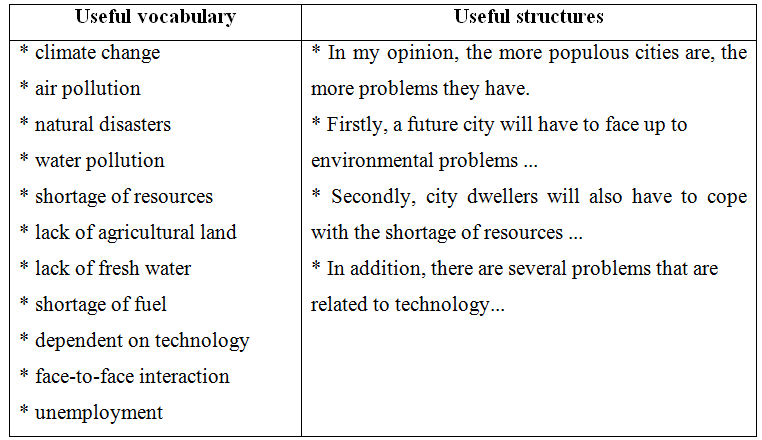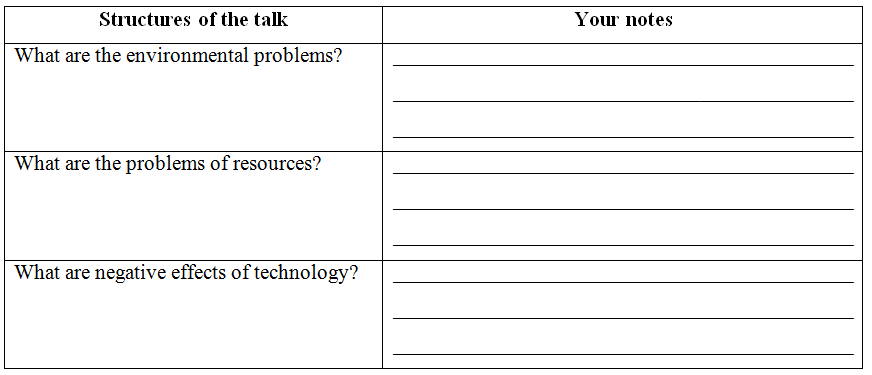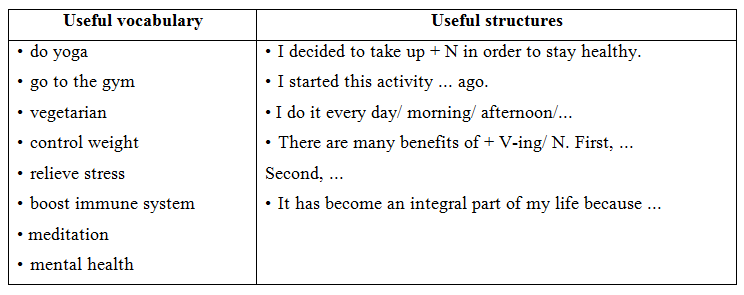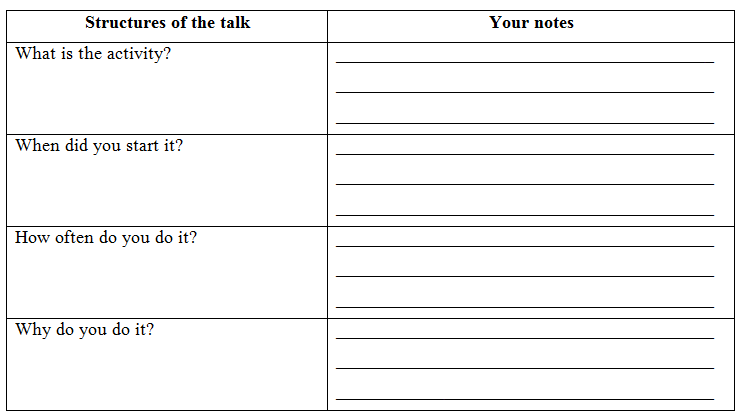Câu hỏi:
01/04/2024 251. Disabled people will account for 15% of city population by 2050.
Trả lời:
 Giải bởi Vietjack
Giải bởi Vietjack
Dịch nghĩa toàn bài:
Các thành phố lớn đang phải đối mặt với các cuộc khủng hoảng lớn. Liên Hợp Quốc ước tính đến năm 2050, gần một tỷ người khuyết tật sẽ sống ở các thành phố, chiếm 15% tổng dân số thành thị. Với cảnh quan đô thị tràn ngập các tàu điện ngầm, cửa hàng và nhà vệ sinh không thể tiếp cận, Liên Hợp Quốc đã công bố rằng khả năng tiếp cận kém hiện là một thách thức lớn đối với các thành phố. Đồng thời, hầu hết các thành phố trên thế giới đang gắng sức để cung cấp nhà ở an toàn, chất lượng hợp lý, giá phải chăng cho công dân, với tiền thuê nhà chiếm hơn 50% tổng thu nhập. Diễn đàn Kinh tế Thế giới gần đây đã cảnh báo rằng một thế giới mà chỉ một số ít người có thể mua được nhà là không bền vững.
Vào thời điểm tương lai của đô thị hóa ngày càng được định hình bởi các công nghệ mới với thiết kế nhằm nâng cao cuộc sống hàng ngày của người dùng, các kiến trúc sư và cư dân đô thị phải nhớ rằng một thành phố thông minh là một thành phố dễ tiếp cận và giá cả phải chăng. Điều quan trọng cần lưu ý là thành phố thực sự dễ tiếp cận là một thành phố mà mọi người thuộc mọi khả năng, thu nhập, chủng tộc, giới tính và tôn giáo, có thể sống và phát triển trong môi trường đô thị tập trung vào trải nghiệm của con người.
Điều này không có nghĩa là công nghệ không có vai trò. Trên thực tế, như chúng ta sắp thấy, cả kiến trúc sư và kỹ sư công nghệ đang có nhiều chọn lựa trong phát triển thiết kế đô thị, từ việc chỉ đường cho người sử dụng xe lăn, đến xây dựng nhà ở vừa với thu nhập ở trung tâm đô thị.
Đáp án: True
Dịch nghĩa câu hỏi: “Người khuyết tật sẽ chiếm 15% tổng dân số thành thị vào năm 2050”.
Giải thích: Thông tin ở câu 2 đoạn 1: “The United Nations estimates that by 2050, almost one billion people with disabilities will live in cities, representing 15% of total city dwellers.”
Dịch nghĩa toàn bài:
Các thành phố lớn đang phải đối mặt với các cuộc khủng hoảng lớn. Liên Hợp Quốc ước tính đến năm 2050, gần một tỷ người khuyết tật sẽ sống ở các thành phố, chiếm 15% tổng dân số thành thị. Với cảnh quan đô thị tràn ngập các tàu điện ngầm, cửa hàng và nhà vệ sinh không thể tiếp cận, Liên Hợp Quốc đã công bố rằng khả năng tiếp cận kém hiện là một thách thức lớn đối với các thành phố. Đồng thời, hầu hết các thành phố trên thế giới đang gắng sức để cung cấp nhà ở an toàn, chất lượng hợp lý, giá phải chăng cho công dân, với tiền thuê nhà chiếm hơn 50% tổng thu nhập. Diễn đàn Kinh tế Thế giới gần đây đã cảnh báo rằng một thế giới mà chỉ một số ít người có thể mua được nhà là không bền vững.
Vào thời điểm tương lai của đô thị hóa ngày càng được định hình bởi các công nghệ mới với thiết kế nhằm nâng cao cuộc sống hàng ngày của người dùng, các kiến trúc sư và cư dân đô thị phải nhớ rằng một thành phố thông minh là một thành phố dễ tiếp cận và giá cả phải chăng. Điều quan trọng cần lưu ý là thành phố thực sự dễ tiếp cận là một thành phố mà mọi người thuộc mọi khả năng, thu nhập, chủng tộc, giới tính và tôn giáo, có thể sống và phát triển trong môi trường đô thị tập trung vào trải nghiệm của con người.
Điều này không có nghĩa là công nghệ không có vai trò. Trên thực tế, như chúng ta sắp thấy, cả kiến trúc sư và kỹ sư công nghệ đang có nhiều chọn lựa trong phát triển thiết kế đô thị, từ việc chỉ đường cho người sử dụng xe lăn, đến xây dựng nhà ở vừa với thu nhập ở trung tâm đô thị.
Đáp án: True
Dịch nghĩa câu hỏi: “Người khuyết tật sẽ chiếm 15% tổng dân số thành thị vào năm 2050”.
Giải thích: Thông tin ở câu 2 đoạn 1: “The United Nations estimates that by 2050, almost one billion people with disabilities will live in cities, representing 15% of total city dwellers.”
CÂU HỎI HOT CÙNG CHỦ ĐỀ
Câu 1:
Talk about problems a city will have to face up to in the future.
You can use the following questions as cues:
• What are the environmental problems?
• What are the problems of resources?
• What are negative effects of technology?
Useful languages:

Complete the notes:

Now you try!
Give your answer using the following cues. You should speak for 1-2 minutes.
1. In my opinion, the more populous cities are, the more problems they have.
2. Firstly, a future city will have to face up to environmental problems ...
3. Secondly, city dwellers will also have to cope with the shortage of resources ...
4. In addition, there are several problems that are related to technology ...
Now you tick!
Did you ...
- answer all the questions in the task?
- give some details to each main point?
- speak slowly and fluently with only some hesitation?
- use vocabulary wide enough to talk about the topic?
- use various sentence structures (simple, compound, complex) accurately?
- pronounce correctly (vowels, consonants, stress, intonation)?
Let’s compare!
Finally, compare with the sample answer on page 190.
Talk about problems a city will have to face up to in the future.
You can use the following questions as cues:
• What are the environmental problems?
• What are the problems of resources?
• What are negative effects of technology?
Useful languages:

Complete the notes:

Now you try!
Give your answer using the following cues. You should speak for 1-2 minutes.
1. In my opinion, the more populous cities are, the more problems they have.
2. Firstly, a future city will have to face up to environmental problems ...
3. Secondly, city dwellers will also have to cope with the shortage of resources ...
4. In addition, there are several problems that are related to technology ...
Now you tick!
Did you ...
- answer all the questions in the task?
- give some details to each main point?
- speak slowly and fluently with only some hesitation?
- use vocabulary wide enough to talk about the topic?
- use various sentence structures (simple, compound, complex) accurately?
- pronounce correctly (vowels, consonants, stress, intonation)?
Let’s compare!
Finally, compare with the sample answer on page 190.
Câu 2:
4. In the future, cars equipped with on-board computers will be able to__________and avoid traffic jams automatically.
4. In the future, cars equipped with on-board computers will be able to__________and avoid traffic jams automatically.
Câu 3:
Listen and fill in the blanks with ONE appropriate words.
1. The global population is predicted to reach___________billion in the future.
Listen and fill in the blanks with ONE appropriate words.
1. The global population is predicted to reach___________billion in the future.
Câu 5:
7. If you want to raise rents, you have to__________the housing first.
7. If you want to raise rents, you have to__________the housing first.
Câu 7:
9. A: We should eat more fruit every day.
B: Fruit is good for health, isn’t it? ________
9. A: We should eat more fruit every day.
B: Fruit is good for health, isn’t it? ________Câu 9:
- Write an essay (150 -180 words) about improvements we will see in the cities in the future.
You can use the following questions as cues:
* How will transportation change?
* How will buildings change?
* How will entertainment change?
__________________________________________________________________
__________________________________________________________________
__________________________________________________________________
__________________________________________________________________
__________________________________________________________________
__________________________________________________________________
__________________________________________________________________
__________________________________________________________________
- Write an essay (150 -180 words) about improvements we will see in the cities in the future.
You can use the following questions as cues:
* How will transportation change?
* How will buildings change?
* How will entertainment change?
__________________________________________________________________
__________________________________________________________________
__________________________________________________________________
__________________________________________________________________
__________________________________________________________________
__________________________________________________________________
__________________________________________________________________
__________________________________________________________________Câu 11:
Choose the best option to complete each of the following sentences.
1. Many types of__________energy such as wind and solar energy will never run out
1. Many types of__________energy such as wind and solar energy will never run out
Câu 12:
4. First change/ city/ future/ be/ change/ infrastructure.
→ ________________________________________________________
4. First change/ city/ future/ be/ change/ infrastructure.
→ ________________________________________________________
Câu 13:
6. A: It’s important for us to have a good command of English.
B: Yes, English is the most popular language in the world, isn’t it? ________
6. A: It’s important for us to have a good command of English.
B: Yes, English is the most popular language in the world, isn’t it? ________Câu 14:
10. A: My brother graduated from university with a good degree.
B: He graduated from Havard University, didn’t he? ________
10. A: My brother graduated from university with a good degree.
B: He graduated from Havard University, didn’t he? ________



